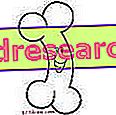In motor reactivation, after any trauma, sprain or not, the muscular reinforcement plays a fundamental role, as a good tropism of the muscles reduces the risk of recurrent lesions and allows the patient to resume full activity before the activity accident.
In the re-education of the ankle after a sprain we must pay particular attention to the movements that we are going to make the patient perform, so as not to proceed immediately with exercises that can cause damage to the compartment that has suffered the trauma. For this reason the first exercises for the recovery of muscular trophism must be carried out on the frontal plane, in order not to put the ligament compartments under tension, especially if they are not completely healed. Later, when the structures that suffered the trauma were recovered, we could also start the exercises on the sagittal plane, again with the patient's pain threshold as a guideline, so as not to overloading the joint early. For this reason it is best to start with very light exercises, divided into several series with few repetitions.
The most used tool for muscle strengthening is the elastic, as it allows the load to be dosed and is very versatile for this type of exercise. To work better on the ankle joint we will seat our patient and make him pass the elastic around his foot. As mentioned above, the focus must be placed in particular on the reaction of the patient as the pain threshold must be our guideline. For this reason we will start with elastic bands that oppose less resistance, then gradually move on to those that oppose a greater resistance, and with reduced movement excursions, also trying to find the maximum range or at least the one before the traumatic episode.
 | The first exercise involves plantar and dorsal flexion of the foot on the frontal plane. Initially we will start with a few repetitions, then move on to increase the repetitions first and then increase the load. |
  | The second exercise will work on the sagittal plane, so we will make the patient perform intra and extra rotation movements, obviously in the same way as in the previous exercise, which in this case will be even more important given that the ligamentous compartments concerned are located at the external of the joint and therefore will be called into question more in the execution of this exercise. |
 |
The same exercises can be performed with the aid of a sponge ball . Always with the subject sitting, if we place the sponge ball in contact with a wall we can perform plantar and dorsal flexion movements by placing the sole of the foot on the ball. With the same method we are going to perform intra and extra rotation movements, placing the inside or outside of the foot in contact with the ball this time. |
  | When the patient is able to walk without lameness and without experiencing pain in the affected area, it is possible to proceed with full load exercises. We can divide these exercises into two categories. The first is for the strengthening of the leg muscles, more precisely for those of the posterior loggia, the second is aimed at strengthening the thigh muscles. Strengthening of the thigh muscles is essential because, even if not directly involved in the joint that has suffered the trauma, in the period of convalescence they have been used incorrectly due to lameness. For this reason it is good to go back to the whole musculature of the limb affected by a good level of muscular trophism. One of the exercises aimed at strengthening the leg is the one that uses a rise, a support, on which we will raise the patient. The affected leg must be fully extended and must rest on the upside while the other must be relaxed and must not rest on the rise. The patient must perform a plantar and dorsal flexion movement of the foot in order to stress the leg muscles. Another exercise with the same purpose provides for the use of a machine, the sittingcalf . This machine seats the subject and makes them rest the pedi on a rise, so as to have their legs bent at about 90 °. Above the knee an adjustable resistance is placed which the patient must raise by performing plantar and dorsal flexion of the foot. |
For the reinforcement of the thigh muscles a machine is used, the leg press . This machine is equipped with a sliding seat and a fixed support for the feet. The patient is placed on the seat and his feet are placed on the fixed platform with legs bent. The exercise consists of extending the legs against the adjustable resistance provided by the machine. This exercise includes some variants, such as the use of a single leg with which you push or use a proprioceptive pillow to be placed between the sole of the foot and the fixed platform, in such a way as to stimulate proprioception together with the force . |
 |
Article written in collaboration with dr. Gianfranco Piemonte, graduate in physical education, personal trainer email:



